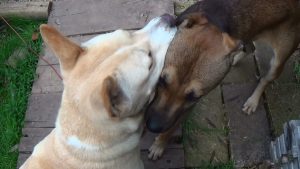Originally published October 21, 2014

Dogs are by nature, social creatures. Even in the wild, they exist in packs: social units that allow for sharing resources, mutual protection and companionship. For domesticated dogs there are two types of socialization: getting along with other dogs, and getting along with people.
There would be a third type if you want to include dogs getting along with other species of animals. However, taking a dog that has grown up thinking that cats, hamsters chickies, rabbits, ferrets, guinea pigs, birds, (whatever you have) are food and teaching it to see them as a friend is beyond my scope or ability.
The most common socialization problem we see here at Piney Mountain Foster Care is dogs who were neglected. Sometimes this is a dog that was chained in the yard, given enough food and water to survive, but that’s about it. No love, no personal care. Blondie was one such dog. When taken in by the Dr. Carol Hood Memorial Animal Shelter, she was so withdrawn and depressed she acted as though she were autistic. More often the problem is a family that decided having a puppy would be fun, but they had no idea how to train it. So the bouncy, happy-go-lucky ball of fur turns into a bouncy, happy-go-lucky dog weighing 30 to 60 pounds and hasn’t got a clue how to behave any way other than what has always done: just being its happy-go-lucky self. This proves inconvenient for the family, so they take it to the shelter to be rid or it — or abandon it somewhere to become someone else’s problem.
Socialization: Dog-on-Dog
Socialization issues between dogs usually arise from their innate sense of pack order. Even resource guarding (fighting over food or treats) is a pack order issue. There can be only one pack leader in a home. That should be you, and all dogs need to know it. Being The Giver of Food goes a long ways toward establishing you as the leader. It is not necessary to establish dominance through the use of force. It is in a dog’s nature to want to please you; using that desire to please, rather than a fear of punishment, will net better results faster and cement a much closer relationship between you.
Dogs can be protective when a new dog is brought into a home. Dogs can be jealous. To prevent trouble you need to be sure you do not give the current dog the idea that he or she is being replaced. Pay more attention to your current dog than the new one during introductions, and make those introductions carefully and in a controlled manner.
Since we’ve had a steady flow of “new dogs” through our place (20 dogs in the past two years +) you’d think that our dogs would be used to having new faces around. But they’re not. And some newcomers are harder to integrate than others, depending on their attitude about pack order. Those who come in thinking they are top dog everywhere will get a stern talking to from Cochise (and will be kept separate from the others until this issue resolves itself). When it’s time for introductions, follow these socialization steps:
Introductions
- Make sure both dogs are on a leash. You want to have complete control over the situation. That means both dogs on a leash and a handler for each dog. Even if your dog is “such a good boy”, there is no guarantee that the other dog is going to do well. Getting in the middle of a dog fight will ruin your day, having a leash and a handler on each dog allows you to pull them apart if things go bad.
- Go for a walk together – but not. It is best to do this on neutral territory so neither dog feels it’s defending it’s turf. Avoid the temptation to let the dogs meet and sniff each other first. As two dogs approach each other the emotional intensity runs high – so it is the most risky time in doggy introductions. Pick a direction to walk and let the new dog and handler walk in front so your dog can watch it, but remain a safe distance behind.
- Praise the dogs. Your goal is to help both dogs relax. Do that by being a supportive, calming presence for the dog you’re handling. Barking or yipping is their way of blowing off steam. Keep them moving, keep them separate, keep praising them: don’t scold for barking, they’re just letting you (and each other) know how they feel. Keeping them moving stimulates their pack hunting nature, which, as described in this article about being calm, assertive, and mooselike, is when dogs are most social. While praising, reward the dog with long, full strokes along his head, neck and back, not vigorous scritchies. The long strokes will be more calming.
- The first sniff. Since your dog is following, it will be the one makes the first sniff – in the rear of the other dog. People consider such behavior inappropriate, and gross: if you did this to someone else, they’d probably take out a restraining order against you. But for dogs, this is how they get to know one another. There are glands around the canine anus that excrete oils. These oils contain pheromones and other agents that tell the extremely sensitive canine nose many things about the other dog’s health and dietary history. The dog being sniffed may react, so both owners need to be vigilant. Try to keep the leashes loose enough the dogs aren’t being choked or dragged (stressed), but able to control them the need arise. After the trailing dog had had a couple of sniffs of the forward dog (and if not violence results) trade positions, so that the new dog has a chance to do the sniffing. Keep them moving, keep them separate, just move past the other dog, then let the other dog move slowly in for their turn to sniff.
- Marking. If one dog defecates or urinates, let the other dog sniff it – after the dog doing the eliminating is done and clear. Again, sniffing excrement is an important exchange of information between the two dogs. Eliminating in each others presence is a sign the dogs are getting used to each other.
- Invitations to play. If one dog makes a play bow, (elbows on the ground butt in the air) that’s a great sign. Do not give in to the play urge just yet. If the leashes get tangled, and the play turns suddenly aggressive you may not be able to separate them. Keep walking, give them a chance to interact a little then back off a little, then in again and be happy that they’re showing signs of being able to get along.
- Dealing with aggression. If aggression flares, immediately (but not violently) move the dogs well apart and work at calming them by distracting them. Getting the aggressive dog to look in another direction removes the fixation. Playing a game with the dog, such as tug, can allow him to vent his anxiety. If you offer treats during or after play, make sure the dogs are well separated so food aggression does not enter the situation. A word on playing tug: let the dog win.
- Together time. After you’ve been walking for awhile, and the dogs have had a chance to sniff each other repeatedly, and if all has gone well, move so that the people are walking next to each other with the dogs to the outsides. What you want is for all of you to be walking next to each other in a friendly group. This gives the dogs a chance to experience more direct visual contact between the two of them while keeping them aligned with a common purpose: the walk (a.k.a. the hunt).
Back at Home
- Defuse Potential Socialization Situations. It’s crucial to avoid squabbles during the early stages of your dogs’ new relationship. Pick up all toys, chews, food bowls and your current dog’s favorite items. When dogs are first forming a relationship, these things can cause rivalry. These items can be reintroduced after a couple of weeks, once the dogs have started to develop a good relationship.
- Their Own Stuff. Give each dog his own food and water bowls, bed and toys. For the first few weeks, only give the dogs toys or chews when they’re separated in their crates or confinement areas.
- Private Dining. Feed the dogs in completely separate areas at first. Pick up bowls when feeding time is over. (Some dogs will compete over bowls that recently contained food.)
- Short Playtime. Keep the dogs’ playtime and interactions brief to avoid over-stimulation and over-arousal, which can lead to fighting.
- Separate Accommodations. Confine the dogs in separate areas of your home whenever you’re away or can’t supervise their interactions.
- His Own Space. Give your new dog his own confinement area. When the dogs are separated, but you are present, let them get to know each other through a barrier, like a baby gate. Your new dog should be gated in his confinement area, your current dog should be free to move around and visit when he wishes.
- Reinforce Good Manners. When the dogs are interacting, interrupt any growling or bullying behavior and quickly separate them for several minutes. Then allow them to be together again. If your dogs seem to react poorly to each other often, don’t hesitate to contact a professional who can help you, such as a Certified Applied Animal Behaviorist (CAAB), a board-certified veterinary behaviorist (Dip ACVB) or a Certified Professional Dog Trainer (CPDT) who’s experienced in treating problems between dogs. See the ASPCA’s article, Finding Professional Help, to locate a professional in your area.
- Praise Often. Be sure to sincerely praise your dogs when they are interacting nicely. Your praise encourages the good behavior.
- Me Time. Spend time individually with each dog. Give each of them training time with you and playtime with other dogs outside your home.
- Respect the Elder. If your dogs are very different in age or energy level, be sure to give the older or less energetic one his own private space where he can enjoy rest and down time.
Once a new dog has been introduced and accepted, he or she may play freely with the other dogs in the current P.M.F.C. clan. We supervise free-play closely and try to limit the numbers to two or three at a time. Competition for the attentions of a dog can also cause friction. If two dogs start a fight, it is common for all of them to join in. That’s very bad in a free-play situation. Anyone showing aggression will be gently removed for a time. Often this is accomplished by simply stepping in and occupying that dogs attention for a few minutes, preventing him or her from playing with the others until the dog calms down. repeated infractions warrants removal from that play area. We have two play areas, so the aggressor does not need to be “sent to his room” (we don’t want to instill the idea that going to their pen is punishment). We also have a “Time out tether” for short term restrictions if a dog that gets overly enthusiastic in their play. Here other dogs may come in to play, but may also escape if the play becomes too rough for them.
More Info:
- How to relax your dog
- Pushing with your dog to help reduce stress
- Playing tug-of-war with your dog
| If you enjoy our updates, Doggy Tales, and educational articles consider subscribing for notices when new pieces are posted. It’s painless and you can unsubscribe any time you want. Your e-mail address is used ONLY to deliver these notices. | [email-subscribers namefield=”YES” desc=”” group=”Public”] |



